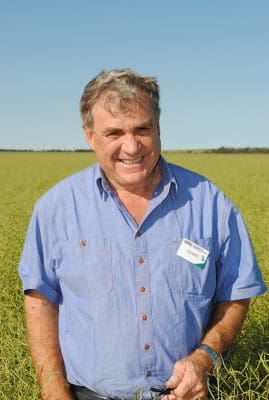A new Western Australian publication provides a range of grower insights into different aspects of Controlled Traffic Farming (CTF).

Some WA growers experienced significant damage to their CTF paddocks as a result of flooding rain in February 2017. Pictured is tramline erosion on the Burrell family’s property in Mt Madden. It took a significant amount of work to repair the damage in time for seeding. (Photo: Cheryl Burrell)
The principle of CTF is to create permanent wheel tracks, commonly called tramlines, which are clearly separated from the crop zone.
The key aim is to reduce compaction and improve soil conditions in the crop root zone to encourage root growth and increase the uptake of soil moisture – to improve grain yields and quality.
The Grains Research and Development Corporation (GRDC) publication ‘Controlled Traffic Farming – Case Studies of Growers in Western Australia’, is an initiative of the GRDC Western Regional Panel.
GRDC Western Regional Panel chairman Peter Roberts said the booklet was designed to identify and extend information about practical CTF methods being used by a range of WA growers.
“Common themes from the case study growers include the importance of layout planning; maintaining and renovating tramlines; and managing machinery replacement,” he said.
Mr Roberts said the publication included detailed information not only about what was working well in growers’ CTF systems, but any adverse issues they might be facing.
“For example, flooding rain in parts of the South Coast, Esperance and Great Southern regions during the 2016-17 summer tested CTF tactics used by many growers.” he said.
“A number of these growers, some of whom are featured in the booklet, experienced significant damage to paddocks including ‘scouring’ of traffic lines, and are now considering adjusting aspects of their CTF systems – such as paying closer attention to tramline maintenance.”
Mr Roberts said the 56-page publication included case studies of 12 growers; technical information from Department of Primary Industries and Regional Development (DPIRD) development office Bindi Isbister; links to additional information; and a glossary.
The booklet covers wide-ranging aspects of CTF systems including:
- Matching a range of machinery wheel and operating widths and ratios
- Tramline management
- Inter-row sowing
- Deep ripping/tillage
- Chaff decks for harvest weed seed control (HWSC)
- Making allowances for sheep or hay production
- Dealing with potential erosion and other adverse issues.
Controlled Traffic Farming – Case Studies of Growers in Western Australia can be downloaded at http://grdc.com.au/ctf-case-studies-wa or, to order a hard copy, contact GroundCover Direct at CanPrint on free phone 1800 11 00 44 or [email protected].
Copies of the booklet are free although a postage and handling charge of $10 applies through GroundCover Direct.
The GRDC is investing in the National Controlled Traffic Farming Conference, scheduled to be held in Perth on August 22-23. For more details go to: www.nationalctfconference.com.au
Source: GRDC


HAVE YOUR SAY